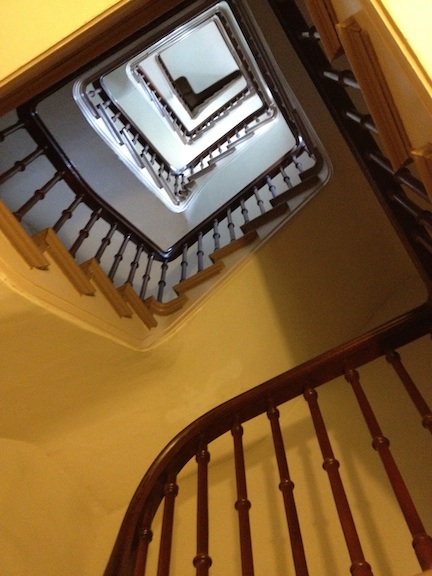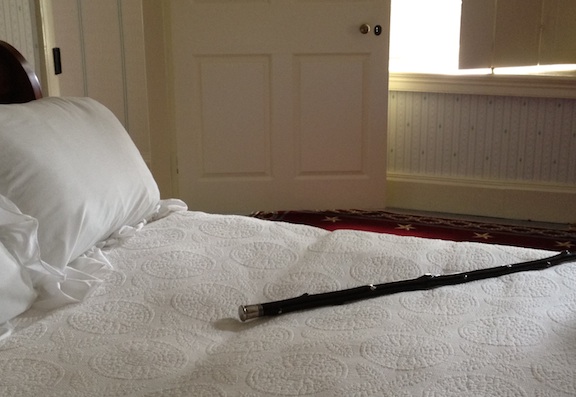A visit with “Old Kinderhook” on the 150th anniversary of his death
 The secession of South Carolina triggered civil war in Martin Van Buren’s house before it ever triggered fighting on the battlefield.
The secession of South Carolina triggered civil war in Martin Van Buren’s house before it ever triggered fighting on the battlefield.
After his public career ended, the former president had retired to the quiet life of a country farmer in his hometown of Kinderhook, just south of Albany, NY. His household included his son, Abraham, and Abraham’s wife, Angelica, who had served as Van Buren’s first lady during the widower’s time in the White House. A cousin of former First Lady Dolly Madison, who had fixed up Angelica and Abraham, had come from South Carolina.

When the Palmetto state seceded, it rankled Van Buren, who had done much during his time in Andrew Jackson’s administration to oppose the Nullification Crisis South Carolina had sparked some thirty years earlier. As tensions mounted between North and South in 1860 and early ‘61, tensions mounted in the Van Buren household—enough so that Abraham and Angelica left the premises for a while.
I arrived on Van Buren’s doorstep just before 11 a.m. yesterday. I’d been passing by the highway exit for Van Buren’s place—the Martin Van Buren National Historic Site—for the better part of four decades as I shuffled back and forth between family in western Pennsylvania and family in Maine. I’ve always said, “I’m gonna stop there someday”—and yesterday morning, at the start of my most recent trek north, that yesterday would be the day.
By sheer coincidence, it happened to be the 150th anniversary of Van Buren’s death.

Van Buren’s presidency often gets overlooked, following on the heels, as it does, of Andrew Jackson’s. It doesn’t help, either, that Van Buren kicked off a twenty-four-year string of one-term presidencies that didn’t end until Abe Lincoln got reelected in 1864. He wasn’t part of the Virginia Dynasty, and his last name wasn’t Adams, so he’s really the first easy-to-forget president we’ve had.
One could make a credible argument, though, that Jackson’s presidency would not have happened without Van Buren’s masterful political maneuverings behind the scenes. He wasn’t called “the Little Magician” for nothing.
The Red Fox built a career starting as an Albany-area attorney; from there, he became a New York state senator, the state’s attorney general, a U.S. senator, New York’s governor, U.S. secretary of state, vice president, and ultimately president. While in office, as legend has it, he initialed documents with a shortened version of another of his nicknames, “Old Kinderhook,” and thus “O.K.” evolved into “okay,” which might be his most enduring legacy.
It’s worth noting, too, that Van Buren was the first American president actually born as an American—on December 5, 1782, just six years after independence. He’s the first president who didn’t come from English or Irish descent; as the son of a Dutch family, English wasn’t even his first language. In 1807, he married Hannah Hoes, a childhood sweetheart who’d grown up with him in Kinderhook. They had five children, but Hannah died after only a dozen years of marriage. He never remarried. During his time in the White House, his daughter-in-law, Angelica—wife of his oldest son, Abraham—served as first lady.
Van Buren failed in his reelection bid because of an economic slump caused by overzealous credit speculation by banks. It was the worst economic depression in America’s history up to that point, and not even the establishment of an independent treasury could save him. In 1848, he failed in a third-party bid for the presidency as the candidate for the Free Soil Party, which his son John had helped found.
The change in allegiance was a big deal for the Little Magician, who had helped found the Democratic Party that then propelled Jackson and, later, Van Buren into the White House. His opposition to the expansion of slavery put him at odds with his own party, triggering the eventual third-party run.
By 1860, in declining health, Van Buren keenly watched the unfolding crisis as Southern states began to secede in the wake of Lincoln’s election. The former president and his former first lady saw the situation from entirely different perspectives, leading to the family split.
As Van Buren’s health deteriorated, though, the family patched things up. Abraham and Angelica came back.
Dependent on his family for news about the war in a year when the Union wasn’t faring so well, Van Buren remained satisfied that the North would achieve victory—but only because his son and daughter-in-law avoided the question, fudged the truth, or lied outright to him. Van Buren died on July 24, 1862 convinced the Union he’d once led would remain preserved.
I stood only a foot and a half from the bed Van Buren died in a century and a half ago to the day. On the bed laid a hickory walking stick—a gift from Old Hickory himself—silver-tipped and engraved, with silver-capped knots that bear the letters to spell out “Andrew Jackson.”
At the Dutch Reformed Cemetery on the far side of the village of Kinderhook, an obelisk stands at Van Buren’s gravesite. It’s been landscaped with flowers and tall fronds of tufted grass. Someone has planted a flag, and someone else has left a wreath bedecked in red, white, and blue.
Van Buren would want to know that his Union was doing all right. I would tell him so, even if it meant stretching the truth a little in Abraham-and-Angelica fashion. On this of all days, Old Kinderhook should rest easy. Things, I would tell him, are okay.





What a great house and great post!!
Thanks. It sure was a neat house to visit.